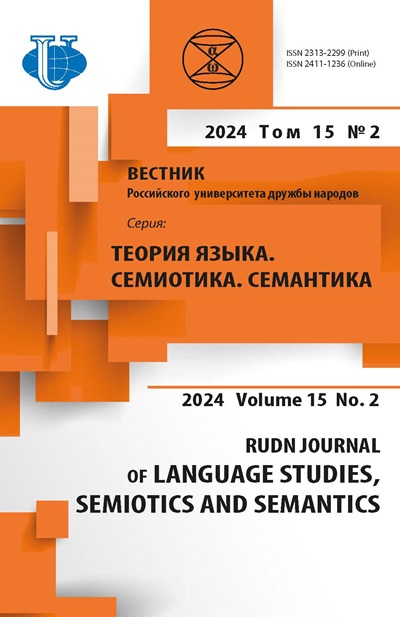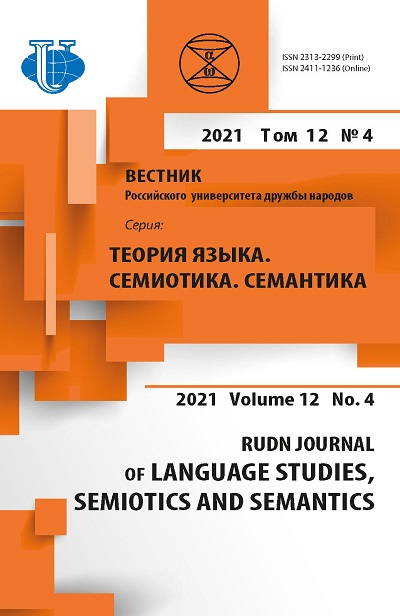Using the Phonological Approach to Describe the Vocal System of the Russian Language in the Context of Russian-Spanish Language Contact
- Authors: Bondareva V.V.1
-
Affiliations:
- Peoples’ Friendship University of Russia (RUDN university)
- Issue: Vol 12, No 4 (2021)
- Pages: 1260-1275
- Section: RUSSIAN LANGUAGE AND INTERCULTURAL COMMUNICATION
- URL: https://journals.rudn.ru/semiotics-semantics/article/view/29891
- DOI: https://doi.org/10.22363/2313-2299-2021-12-4-1260-1275
Cite item
Full Text
Abstract
The article is devoted to the description of the vocal systems of different languages, considering the functional approach, based on the objective linguistic reality. Today the traditional approach used by research scientists is gradually losing the ability to identify effective models of the phonetic-phonological system of the language, which significantly affects the productivity and research results. The rapid development of new directions of science, the evolution of the language system and all its sublevels indicates the need to adjust the traditional principles of describing phonetic-phonological systems of different languages and imposes special requirements on the relevance, productivity, adequacy and compliance of such descriptions with objective reality. The article analyzes the system of vowels from a phonological point of view - a general classification of vowels through the prism of phonological systematics of meaningful oppositions - considering the articulatory base of the language and the modern orthoepic norm, their changes in the flow of speech, an inextricable connection with consonantism and the prosodic organization of the word. This system is more productive and relevant for solving the problems of modern linguistics. The approbation of the vocal system of the Russian language, obtained within the framework of the corrected approach to the description of systems, is carried out in conditions of language contact, since the problems of language contact are interconnected with the main tasks of the theory of language in the framework of the comparative historical description and comparison of languages. Phonetic interference, together with a foreign accent, is a consequence of the contact between the native language and the target language. Phonetic interference, being an integral part of linguistic contact, causes a violation of the sound side of the language of foreigners. After analyzing the descriptions of the vocal systems of the Spanish and Russian languages, made within the framework of the adjusted functional approach, it is possible to highlight the main features of the Spanish accent in the pronunciation of Russian vowel sounds, and the analysis of the practical material confirms all the selected features and demonstrates the high efficiency of the above approach. The results of this work can be used in various theoretical courses, as well as to create systems for automatic synthesis and speech recognition.
About the authors
Veronika V. Bondareva
Peoples’ Friendship University of Russia (RUDN university)
Author for correspondence.
Email: bondareva-vv@rudn.ru
Assistant at the Institute of Russian Language
6, Miklukho-Maklaya str., Moscow, Russian Federation, 117198References
- Baudouin de Courtenay, J. (1963). Selected Works in General Linguistics. Volume 1. In 2 volumes. Moscow: Publishing House of the USSR Academy of Sciences. (In Russ.).
- Trubetzkoy, N.S. (2000). Principles of Phonology. Moscow: Aspect Press. (In Russ.).
- Jakobson, R. (1985). Selected Writings. Moscow. (In Russ.).
- Jakovlev, N.F. (1928). The Mathematical Formula of the Structure of the Alphabet (the Experience of the Practical Application of Linguistic Theory). In: Culture and Writing of the East. Vol. I. Moscow. pp. 41—64. (In Russ.).
- Zinder, L.R. (2007). General Phonetics. Moscow: Akademiya. (In Russ.).
- Bondarko, L.V. (2002) Triphthong. In: Linguistic Encyclopedic Dictionary. Moscow: Bol’shaya rossijskaya enciklopediya. (In Russ.).
- Reformatsky, A.A. (1970). From the history of domestic phonology. Moscow: Nauka. (In Russ.).
- Loginova, I.M. (1992). Description of the Phonetics of Russian as a Foreign Language (Vocalism and Stress). Monograph. Moscow: RUDN University Publ.(In Russ.).
- Bondarko, L.V. (2002). Vowels. In: Linguistic Encyclopedic Dictionary. Moscow: Bol’shaya rossijskaya enciklopediya. pp. 949—960. (In Russ.).
- Bondarko, L.V. (1965). Oscillographic Speech Analysis. Leningrad: Publishing House of Leningrad University. (In Russ.).
- Verbitskaya, L.A. (1965). Sound Units of Russian Speech and Their Relationship with Shades and Phonemes (Based on Russian Vowels) [dissertation]. Leningrad. (In Russ.).
- Verbitskaya, L.A. (1977). Modern Russian Literary Pronunciation (Theoretical Problems and Experimental Data) [dissertation]. Leningrad. (In Russ.).
- Likhtman, R.I. (2001). On the Issue of Pronunciation Styles of the Russian Literary Language. In: Collection of articles on the 80th anniversary of M.V. Panov. Moscow: Yaziki slavyanskoi kul’tury. pp. 197—210. (In Russ.).
- Bondarko, L.V. (1977). The sound system of the modern Russian language. Moscow: Prosveshchenie. (In Russ.).
- Trubetzkoy, N.S. (1990). Common Slavic Element in Russian Culture. In: Topics in the study of language, 3, 114—134. (In Russ.).
- Malakhova, M.G. (2018). The relevance of the study of the problem of sound interference in teaching Russian pronunciation to foreign students at the university. In: Actual Problems of Natural Sciences and Humanities, 3 (110), 56—59. (In Russ.).
- Weinreich, U. (1979). Languages in Contact: Findings and Problems. Kyiv: Vishcha shkola. (In Russ.).
- Budnik, E.A. & Loginova, I.M. (2012). Aspects of the Study of Sound Interference (Based on Russian-Portuguese Bilingualism). Monograph. Moscow: MESI. (In Russ.).
- Bekhtereva, N.P. (ed.) (1988). Mechanisms of Human Brain Activity. Part I. Human Neurophysiology. Leningrad: Nauka. (In Russ.).
- Polivanov, Е. (1931). La perception des sons d’une langue étrangère. In: Travaux du Cercle Linguistique de Prague, 4. Réunion phonologique internationale tenue à Prague (18—21 décembre 1930). Prague. pp. 79—96.
- Bernshtein, S.I. (1975). Questions of Phonetics and Teaching Pronunciation. In: Questions of Phonetics and Teaching Pronunciation. Moscow: Publishing House of Moscow University. pp. 5—49. (In Russ.).
- Galeeva, M.M. (1977). On Some Methods of Learning a Foreign Accent. In: Phonetic Research for Teaching Foreign Students Russian Pronunciation. Moscow: Patrice Lumumba Peoples’ Friendship University Publ. pp. 40—47. (In Russ.).
- Georgiou, G.P., Perfilieva, N.V., Denisenko, V.N. & Novospasskaya, N.V. (2020). Perceptual Realization of Greek Consonants by Russian Monolingual Speakers. Speech Communication, 125, 7—14. doi: 10.1016/J.SPECOM.2020.09.008
- Sawsan Askoul (2017). An acoustic analysis of the production of word-initial stop /p/ by late Arab bilinguals. Training, Language and Culture, 4 (1), 68—83.
- Quilis, A. & Fernández Joseph, A. (1996). Curso de fonética y fonología españolas. Madrid.
- Navarro Tomas, T. (1946). Escala de frecuencia de los fonemas españoles. In: Estudios de fonología española. Syracuse. pp. 15—30.













